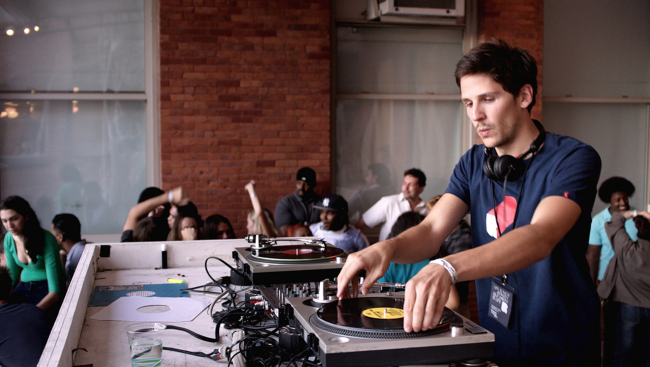Hansen-Love’s fourth feature also serves as a reminder. Few of us in this life monetize our passions on a grand scale. Mostly there are those who glide along, doing their thing, doing what they can to support their thing, becoming neither legends nor failures.

This isn’t the usual terrain of movies devoted to music. We meet skinny, shy, charismatic Paul, played by Felix de Givry, in 1992. He’s a teenager on the make, navigating his first illegal rave somewhere outside Paris. He and his affable friend Stan (Hugo Conzelmann) absorb all the new sounds like sponges, particularly the trancelike so-called Garage music coming out of New York. In the early morning light along a river, Paul enters a converted submarine decorated to look like a party lounge. The mood is quiet, but the air is charged with creative and sensual possibility, just as it was for the river dwellers of Jean Vigo’s 1930s classic “L’Atalante.”
Paul and Stan form a duo called Cheers, and their deejay skills point the way forward. They, and the film, roll through the years to the new century. “Eden” follows after these two as well as their friends and colleagues. Paul’s American girlfriend, played by Greta Gerwig, drops into his life for a time, and then out again. Inhabiting a parallel section of the same fertile Paris club scene, the members of Daft Punk become local heroes, and then international ones, while Paul and Stan enjoy reasonably steady work, taking them to New York early in the new century.
“Eden” is a sideways kind of story, its levels of fame and disappointment distinct but not melodramatic. Paul struggles with cocaine, debt and, in his 30s, the creeping sensation that the beat is going on without him, and it’s not really his beat anymore. His stormy, yearslong affair with Louise (terrific Pauline Etienne, a tough-willed “Cosette,” as Paul calls her) fades but there’s an intriguing postscript, a scene in the seaside town where Pauline has relocated with her new man and their two kids. Earlier, in a New York sequence, Paul reconnects with the Gerwig character. Fireworks? Not really; more like flickers of old, fond feeling.
Hansen-Love wrote the script with her brother, Sven Hansen-Love, basing it on his deejay experiences. “Eden” empathizes with everyone on screen, from the moody graphic novelist Cyril (Roman Kolinka) to a freelance music journalist/scene-maker/riddle (Vincent Macaigne) who hosts late-night viewings of “Showgirls.” Hansen-Love’s camera captures the hours and days and years spent on the road through young adulthood. Photographed in gorgeous, supple widescreen by Denis Lenoir, “Eden” comes alive as cinema most vividly on the teeming dance floors of the venues Paul and Stan fill with their smooth, hypnotic brand of electronica, “like House but more Disco,” as Paul calls it years later.
At its Toronto film festival bow “Eden” drew comparisons to the Coen brothers’ “Inside Llewyn Davis.” That film was about the guy (fictional) who didn’t quite become Bob Dylan. “Eden” presents the guys (also fictional) who didn’t quite become Daft Punk. The Coens’ film is a wisenheimer, a mordant black comedy. “Eden” is utterly different, more muted and humane in tone. It won’t be enough for some audiences. Hansen-Love treats Paul’s story, unremarkable in many aspects, as a study in forward motion -- on the turntable, on the dance floor, on motorcycles. By 2013, the time of the film’s final chapter, Paul has begun to change, and to process what he has been through. It’s not a euphoric ending, nor a melancholic one. It’s in the middle.
By Michael Phillips, Chicago Tribune (TNS)







![[Hello India] Hyundai Motor vows to boost 'clean mobility' in India](http://res.heraldm.com/phpwas/restmb_idxmake.php?idx=644&simg=/content/image/2024/04/25/20240425050672_0.jpg&u=)










